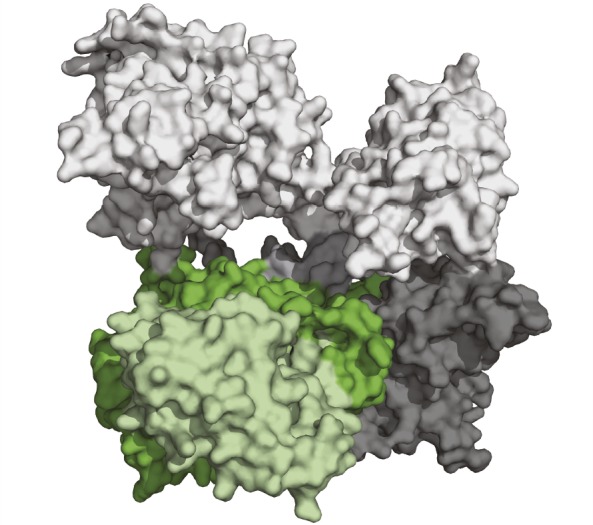Expanding the temperature range of CRISPR-Cas9

Homology model of IgnaviCas9, with colors indicating various domains.
CRISPR-Cas9 has become a valuable tool for genome editing, but most Cas9 enzymes are active only at moderate temperatures. Stephanie Tzouanas Schmidt et al. (pp. 23100–23105) identified a Cas9 protein from unculturable Ignavibacterium that can cleave nucleic acids at elevated temperatures and with high stability. The authors discovered the enzyme, which they named IgnaviCas9, from mini-metagenomic sequencing of sediment samples from the Lower Geyser Basin of Yellowstone National Park, where temperatures can exceed 90 °C. When the authors expressed, purified, and characterized IgnaviCas9, they found that the enzyme was active at temperatures up to 100 °C in vitro and acts across a wide thermal range; the commonly used Streptococcus pyogenes Cas9 has a limit of 44 °C. The authors used IgnaviCas9 during the polymerase chain reaction amplification step of bacterial RNA-seq library preparation and showed that IgnaviCas9 can be used to cleave undesirable 16s ribosomal RNA fragments and reduce the fragments’ presence in the library without adding an additional cleanup step to the workflow. According to the authors, IgnaviCas9 expands the temperature range of CRISPR-Cas9 and its thermostability could lead to novel molecular biology applications. — S.R.
Introgression and beak size in Darwin’s finches
When an interspecific hybrid breeds with one of its parent species, alleles from one species enter the gene pool of another species through introgressive hybridization. This process can yield new morphological traits and new species, but how this may have happened throughout evolutionary history is not clear. Peter Grant and B. Rosemary Grant (pp. 23216–23224) examined past and present hybridization of Darwin’s finches in the Galápagos Islands. The authors analyzed phylogenetic data in addition to breeding events, microsatellite DNA data, and beak measurements from 1973 until 2012 and found that variation in beak size was greatest in species of intermediate age. This finding supports the prediction that variation should initially increase through introgressive hybridization and subsequently decline due to genetic incompatibilities. From 1983 onward, the proportions of hybrids in populations of the cactus finch (Geospiza scandens) and the medium ground finch (Geospiza fortis) generally increased across years. The average beak length of G. scandens became shorter from 1987 onward, supporting the idea that introgressive hybridization occurred between this species and the smaller species, G. fortis. Moreover, variation in G. fortis beak dimensions increased from 1983 to 2004. Because beak size affects the ability of finches to crack seeds and open fruits, the findings suggest that introgressive hybridization can alter ecologically important morphological traits, according to the authors. — J.W.
History of drug-resistant tuberculosis strain in South Africa
To prevent epidemics of antimicrobial-resistant (AMR) infections, public health professionals require evidence-based strategies to contain the pathogens soon after they emerge. Although an expansive body of knowledge exists about the acquisition of drug resistance, AMR infections are typically identified long after key steps in the process occur and in locations distant from their geographic origin. Tyler Brown et al. (pp. 23284–23291) used whole-genome sequence data to reconstruct a detailed pre-detection history of LAM4/KZN—a highly successful, extensively drug-resistant tuberculosis (XDR-TB) strain first identified in 2005 in cohospitalized HIV patients in Tugela Ferry, KwaZulu-Natal, South Africa. The authors report that LAM4/KZN, currently the primary cause of XDR-TB in the province, emerged around 12 years before the 2005 outbreak and approximately 400 kilometers from Tugela Ferry, in a district where drug-resistant TB was already endemic. Subsequently, the strain expanded as the generalized HIV epidemic spread across the province, although this concurrence only explains part of the strain’s success. The authors also used protein structural modeling to suggest a mechanism by which strain-specific mutations can offset the evolutionary fitness costs of acquiring TB drug resistance. According to the authors, the study demonstrates that genomic analyses can offer a potential strategy for early containment of AMR epidemics. — T.J.
Speech and social class perception
Speech patterns are among the most significant means of social class perception. Using audio of speakers collected from the International Dialects of English Archive, Michael Kraus et al. (pp. 22998–23003) explored whether hearing only speech allowed strangers to identify social class accurately. When 229 participants listened to 27 speakers uttering 7 words, the listeners accurately predicted the speaker’s age, gender, race, and social class more than 50% of the time, which is the random guess rate. However, social class judgments were less accurate than judgments of the other categories. The authors also asked 302 participants to predict the social class of 35 speakers after listening to or reading a transcript of each speaker’s self-description. Speaker social class was correlated positively with predicted social class in the speech condition, and participants made more accurate predictions after hearing speech than reading an identical transcript. In a separate experiment, 274 participants with hiring experience listened to answers to preinterview questions from 20 prospective job candidates who varied in social class and were recruited from the broader New Haven, Connecticut, community. Participants judged the competence, fit, starting salary, and signing bonus of the candidates in favor of those from higher social class backgrounds, compared with those from lower social class backgrounds. The findings suggest that speech patterns may perpetuate social inequality, according to the authors. — M.S.


